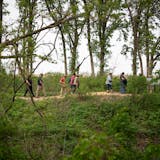Several Minnesota school districts are looking at pushing back their school start time, particularly for high school students, who gain the most from extra sleep.
Buffalo-Hanover-Montrose, Willmar and Wayzata are among the districts contemplating such a move, while St. Paul Public Schools recently decided to conduct a pilot project next school year at Johnson Senior High, which will start an hour later.
Minneapolis Public Schools just wrapped up exhaustive survey work to gauge parents' and students' thoughts on school start and dismissal times. The move also comes after the release of a definitive study on the benefits of starting school later.
"One thing that really struck me was the first time I heard one of the sleep researchers say that early start times can have harmful effects on students, particularly secondary students," said Pam Miller, Buffalo-Hanover-Montrose's director of teaching and learning. "Why on earth would we want to harm our students?"
Last March, researchers from the University of Minnesota's Center for Applied Research and Educational Improvement (CAREI) finally put to rest the long-standing question of whether later start times correlate to increased academic performance for high school students. The answer: It does.
Researchers analyzed data from more than 9,000 students at eight high schools in Minnesota, Colorado and Wyoming and found that shifting the school day later in the morning resulted in a boost in attendance, test scores and grades in math, English, science and social studies.
Schools also saw a decrease in tardiness, substance abuse and symptoms of depression. Some even had a dramatic drop in teen car crashes.
Since the study's release, CAREI's director, Kyla Wahlstrom, said she's heard from schools across the country, many of which had previously been on the fence about whether to push back start and dismissal times.
![Three weeks ago, Octavio Rodriguez switched from making transmission parts to casting parts for hospital bed brake assemblies at Twin City Die Castings. ] GLEN STUBBE • glen.stubbe@startribune.com Thursday, April 9, 2020 How employee-owned Twin City Die Casting, which just laid off 40 production workers of its 250 employees in what was supposed to be a good year, is trying to accelerate its pivot to growing medical parts business for ventilators, hospital beds, etc as it copes with instan](https://arc.stimg.co/startribunemedia/WNZYKGTZ5IYMUCO3KI5TR3N7WI.jpg?&w=80&ar=1:1&fit=crop)

djoles@startribune.com As boaters flock to Minnesota lakes and rivers this holiday weekend for the unofficial kick-off to the boating season, they'll face more inspections in and out of the water as local cities and counties ramp up their work to stop the spread of invasive species. Across the metro, more boat accesses will be staffed by watercraft inspectors thanks to $10 million funneled to county government programs this year, up from $4.5 million the state allocated last year. ORG XMIT: MIN1505222156290209 ORG XMIT: MIN1506021218440580](https://arc.stimg.co/startribunemedia/34QSKO44B2XKVNUZCO5SLJQSLY.jpg?&w=80&ar=1:1&fit=crop)
